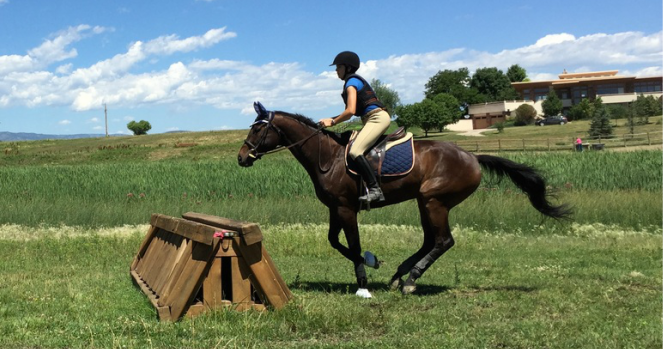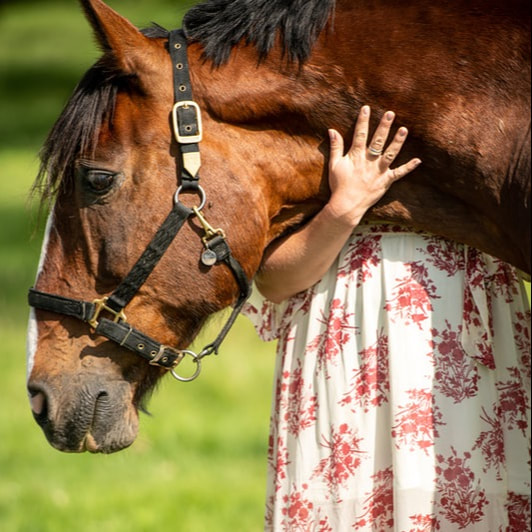|
Jumping horses takes a fair amount of skill. Some beginner riders can walk, trot, canter, and gallop roughly on a horse the first time they ride depending on their balance and fitness. Very few can jump until they have learned how to properly ride a horse, and even then, the adrenaline rush you get soaring over fences is huge. There is a fairly small population of people that can jump and they don’t get a rush, their heart rate stays the same, and they end their ride as if they just took a stroll in the park, calm and collected. I admire those folks and tip my hat to them with gratitude that they exist, and then there is the rest of us… heart pounding, muscles tense, just trying to stay breathing is hard enough let alone focusing on distance and technique. For most riders, technique goes flying out the window when we jump horses and we are just trying to stay on and get from jump to jump in an organized and precise fashion. I can’t tell you how many people I talk to that, when they are being honest, have huge anxiety when they jump, they are just trying to keep in together and convince themselves they are having fun. I hear, “I try not to think about it” or “I just kind of go numb and surrender to the fact that I might die today.”
Jumping horses can most definitely trigger anxiety or panic and I see anxiety attacks on a weekly basis. Riders come up to me, breathing heavy, body shaking, tight upper chest breaths as their arm muscles are still tight from the ride. No wonder horses get tense over jumps! If we are asking horses to connect and pick up on what we are asking them to do, then we are asking them to hold their breath, bottle their tension, and be tight. I can see why they buck or take off regularly let alone be anxious themselves! But when all is said or done, it is just you, the horse, and the jump. Nothing more. We can try to tell our adrenaline or anxiety to be quiet, but the reality is if you think you are going to die, and you tell your body that, your body is going to go into fight, flight, or freeze, which none of these states are good for riding in. At the same time, you are not going to improve your anxiety of riding or what challenges you by avoiding it. The work with any obstacle is to focus, feel the anxiety, and not let it get the best of you. The anxiety might start when you see a horse, when you mount the horse, when you canter, or go over a pole, or jump a 3’6” box oxer. Wherever your anxiety starts, start there. Notice it. Breathe into it. Feel how safe or unsafe you feel and don’t lie to your body with what you are able to do. Find that boundary where it feels difficult but safe and hang out there for a while. Most people have the technique, we can keep a leg on each side of the horse, we can stick with their balance, do a two-point. What we lack is the calmness to see what is truly in front of us - Not a lion, not a death trap, or a never ending cliff, but a jump. This is true for all issues of anxiety, we convince our bodies that we are going to die when we don’t really see the reality in front of us. This is just a challenge that we can indeed walk away from if we choose. Most of us think we have to do what makes us feel unsafe and dangerous, but we don’t. From most things, we can walk away, but if we do decide to face our “inner lion” of everything that we fear, we need to do it knowing we can, nourishing our bodies to give us bravery, breathe deeply, knowing we can say “no” if we need to. The challenges are opportunities to be more still, more centered in the moments of chaos. When we see that our challenges, our jumps, they just lie in the path we are walking, we don’t need to walk differently, just take it in stride, literally.
3 Comments
10/15/2018 11:12:34 pm
Without a doubt, It isn't obligatory that the activity will be taken by the insightful understudies. It tends to be taken by any understudies.
Reply
9/25/2019 08:40:14 am
It’s good to share information with others. I am also sharing something very important for students seeking <a href="https://www.matlabsolutions.com/matlab-assignment-help.php">MATLAB Assignment Help</a>. Visit MatlabSolutions and get best assistance in your MATLAB, Simulink Assignments and Projects.
Reply
Leave a Reply. |
AuthorKaia Livingstone is a psychotherapist who runs a private practice outside of Boulder, CO. She specializes in helping horses and humans bond in order to help them relate and connect on a deeper level as well as heal and grow. Archives
July 2023
Categories |

 RSS Feed
RSS Feed
